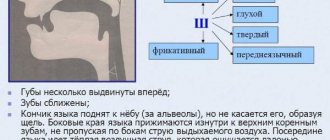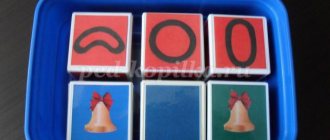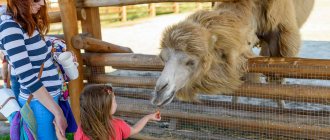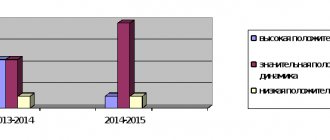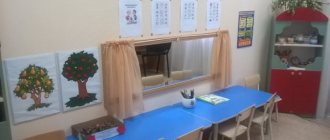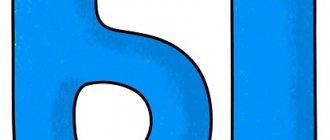Self-analysis of speech therapy classes material on speech therapy on the topic
Self-analysis of a speech therapy session
Theme: “The Journey of a Playful Kitten”
Goal: Development of children's speech through the use of non-traditional game exercises for the development of fine motor skills.
Tasks:
Speech development:
— Automate the correct pronunciation of the sound “sh” in isolation, in syllables, words, sentences, and phrases.
— Develop the ability to answer questions in complete sentences.
Cognition:
-Strengthen fine muscles, develop dexterity, coordination of movements of fingers and hands.
— Develop children’s curiosity, attention, imagination, and thinking when working with unconventional techniques
Social and communicative development:
— Develop communication skills.
- Cultivate a friendly attitude towards others.
The activity began with a surprise moment; all the techniques were of a playful nature, which aroused interest and fairly high activity in the children from the very beginning of the educational activity. This allowed me to involve each child in the educational process, where I acted as a partner, an assistant, and was involved in activities along with the children. We developed a trusting relationship, which allowed us to create psychological comfort for the children.
All aspects of the lesson are interconnected, logical and consistent, subordinated to a given topic and goal.
Changing the types of activities at each stage of the lesson made it possible to prevent fatigue and oversaturation with any one type of activity. The children dynamically switched from one play exercise to another, and interest was constantly maintained.
The activity was built on emotional well-being through direct communication with each child. She stimulated children's activity and tried to build a dialogue with each child.
Support for children's individuality and initiative was provided, and conditions were created for children to freely choose materials during practical activities (when they laid out paths for the kitten). She took into account the age and mental individual characteristics of children. Provided self-control and mutual control of children.
Analyzing the activities of children, I would like to note that they showed cognitive activity, reacted emotionally to methods of activating activities, and used existing knowledge and skills. They were interested, attentive, organized. Children were offered tasks that encouraged them to solve assigned problems. Encouraged indecisive and shy children to speak out.
The duration of the lesson corresponds to San Pin standards. The logical structure of the lesson made it possible to conduct it without going beyond the time allotted for completing the task.
The lesson optimally combined the collective developmental nature with an individual approach to children. An individual approach was organized with children whose speech is poorly developed, with uncommunicative and silent children to enhance their speech activity.
The material of the lesson corresponded to the age-related capabilities of the mental and speech development of children and was developmental in nature. The speech activity of children is organized at a sufficient level of difficulty. The lesson was also educational in nature.
Children's interest was maintained and developed through entertainment, selection of gaming techniques, imagery and colorful material. It evoked positive emotions in children.
Analyzing the lesson, we can say that the assigned tasks were successfully completed.
The children pleased me that the kindness of the child’s soul, their curiosity was felt throughout the entire lesson and in the practical part of the activity,
At every moment of activity, I helped to gain new experience, enhance independence and maintain a positive emotional mood. Creating situations intensified the children’s mental and speech activity. The specifics of working with children in the classroom were reflected in a person-centered approach. She encouraged and praised the children in order to consolidate their situation of success. During the lesson, I tried to communicate with the children on the same level, maintain interest throughout the entire time, and gave freedom for self-expression.
Used verbal and practical methods aimed at using speech, cognitive, practical skills and abilities and improving them. The proposed tasks were given in order of increasing complexity, which contributed to the solution of the assigned tasks for the development of attention, imagination, memory, and speech. Throughout the entire activity, the children were friendly, responsive, and helped each other.
Thus, all conditions were created for the development of fine motor skills and speech activity. The final part was short and emotional. I tried to create a situation of success for the child, a desire to continue and develop the acquired knowledge and skills in the future.
Self-analysis individual speech therapy session based on the fairy tale by K. I. Chukovsky “The Tsokotukha Fly”
Self-analysis of an individual speech therapy session
The date of the: 22.01.2016
City (district) MBOU "Education Center No. 57"
Lesson form ( individual
) Topic
“
On the lexical topic
“Automation of the sound [zh] in syllables, words and phrasal speech (based on the fairy tale by K. Chukovsky “The Tsokotuha Fly” )
Age, number of children:
1 child of the preparatory group.
Speech therapy conclusion
ONR III level
Purpose
– consolidation of the correct pronunciation of the sound [zh] in isolation, in syllables, words and pure phrases.”
Tasks:
Correctional and educational:
- Develop the ability to form adjectives from nouns.
- Develop syllable reading skills.
- Cultivate perseverance and accuracy Correctional and developmental:
- Develop fine motor skills of the fingers.
- Develop articulatory motor skills.
- Develop phonemic awareness.
- Develop visual and phonemic perception, attention.
- Strengthen the skill of sound automation [zh] in syllables, words, and phrases.
- Develop the skill of syllabic analysis.
Correctional and educational:
- Cultivate moral qualities: kindness, responsiveness.
- Cultivate perseverance, respect for nature, and feelings of empathy.
- Foster independence in work, initiative, responsibility
The lesson was conducted with a child with ODD level III and corresponded to the plan of correctional work and the requirements of the program by T. B. Filicheva, G. V. Chirkina for children with ODD, taking into account the recommendations of the approximate basic general education program of preschool education “From birth to school”, ed. N. E. Veraksy, T. S. Komarova, M. A. Vasilyeva. Goals and objectives correspond to the targets of the Federal State Educational Standard for Education. The speech material corresponds to the goals and topic of the lesson, which is structured logically and consistently.
The goals were achieved through solving a number of tasks: developmental, educational, educational and health-improving. was communicated to the child, was understandable to him and corresponded to the content of the lesson. The selected methods and techniques corresponded to his age and were selected taking into account his individual characteristics (state of attention, degree of fatigue, etc.). Visual and verbal instructions were presented accurately and clearly. The following assistance was used: attracting attention, stimulating verbal and mental activity through demonstration, joint activities, using questions of different types (direct, leading, prompting, using visual supports (presentation slides). The stages of the lesson were interconnected and sequential.
The structure of the GCD is built from the following elements: organizational moment - guessing the riddle, which was the goal of the lesson; creating conditions for solving the problem; in order to develop speech motor skills and prepare the child’s speech apparatus, articulation gymnastics was carried out (using a presentation). In order to prevent fatigue, fun finger exercises and physical exercises were carried out, which help relieve fatigue and develop fine motor skills; consolidation and generalization of the child’s knowledge in a playful way; outcome, where children achieve their goals.
To implement tasks during educational activities, I used various pedagogical technologies: electronic educational resources, ICT, gaming and health-saving technologies.
- She interested the child by creating conditions for the emergence of motivation for new activities: the presence of a surprise moment - riddles, viewing a presentation and completing an article for hissing ones, listening to the audio fairy tale “The Fly-Tsokotukha”, didactic games “Find the Letter”, “Buzzer Houses”; object pictures (words with sound [zh]).
2. Organization of GCD:
a) during the lesson, sanitary and hygienic requirements were observed, the alternation of activities, the focus on maintaining the child’s posture, the duration of the lesson, air thermal conditions, lighting;
b) the structure and content of the lesson correspond to the proposed topic, meets the goals and objectives, and corresponds to the age characteristics of the child;
c) in NOD several methods of educational activities were used: visual (showing art/g actions, looking at subject pictures, slides); verbal: teacher’s story, questions, reasoning, conversation; gaming: didactic games “Find the letter”, “Buzzer Houses”; practical: drawing (drawing lines)
d) modern technologies were used in GCD: ICT (viewing slides, listening to audio); gaming (active game, surprise moment-riddles);
e) all types of educational areas were implemented in GCD: social and communicative development (communication and interaction of a child with an adult, development of independence, development of emotional responsiveness); speech development (development of coherent speech, analysis and synthesis, enrichment of active vocabulary); cognitive development (development of ideas about insects); artistic and aesthetic development (perception of audio recordings, fiction, implementation of independent activities); physical development (articulation and finger gymnastics, logorhythmics);
f) throughout the entire lesson, there was a gradual change in types of activities, which made it possible to maintain a positive emotional mood in the child (practical, communicative, gaming);
g) throughout the entire lesson, the child was actively involved in the activity, answered questions with interest, participated in conversations, and completed tasks;
h) during the lesson, I called the child by name, gave him the opportunity to speak, listened to the answers to the end, observing etiquette in communicating with the child. During the lesson, I used knowledge about the individual emotional characteristics of the child, which helped to implement an individual approach. This was manifested in the fact that tasks of varying degrees of difficulty were accompanied by comments, and sometimes “advance” praise and support;
f) the speech material is selected and presented in an accessible form, although quite difficult words and complex tasks were taken, which in turn indicates the implementation of the development principle;
j) throughout the entire lesson, the child maintained a positive emotional mood, I used a verbal system of encouragement for the girl, following the playful motivation, interest in the result was maintained throughout the lesson;
4. At the end of the lesson, I conducted an analysis of the lesson and reflection (the girl listened with great pleasure to the audio fairy tale “The Cluttering Fly”).
During the NOD, the following objectives were achieved: developmental; (development of coherent speech, logical thinking, visual attention, phonemic processes, cognitive interest); educational; (the ability to correctly answer questions, perform exercises, reinforced the way to correctly hold a pencil when drawing lines); educational; (raised positive attitudes towards insects, emotional perception of fairy tales).
5. During the lesson, the girl was active, interested, with a positive emotional attitude, showed a positive attitude towards the result of the activity, and tried to complete tasks carefully and correctly.
I think the lesson was very intense, a large amount of work was done, the tasks completed showed that the goals of the lesson were achieved.
